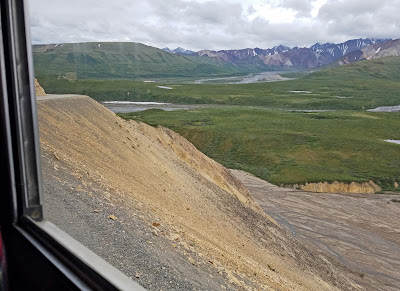Day 16
1964, the Plan: Juneau, AK.
1964, the Actuality: On Saturday, August 1, the Explorer Scouts stayed in Cantwell, AK, waiting for the Alaska Railroad to deliver a new engine block. They camped near the Cantwell Depot, which was next to the Cantwell airstrip.
 |
| 1964: Cantwell Depot (Dr M) |
 |
| 2017: Cantwell does not seem to have a depot anymore (6/28/2017, KSS) |
 |
| 1964: Cantwell view towards the camping site (KSS) |
 |
| 2017: Cantwell view from the airstrip (6/28/2017) |
 |
| 1964: Cantwell view of camping site (Dr M) |
 |
| 2017: Cantwell view from the railroad tracks (6/28/2017) |
Thursday, June 29, 2017
We spent the day in Denali National Park.
 |
| 2:30 am |
First stop.
 |
Murie Science and Learning Center promotes education
and research within the National Parks of northern Alaska;,
named for the Murie family of naturalists, including Adolph Murie
who studied wolves in Denali in the 1930s |
 |
Students wrote what they hoped
was still here in 100 years.. |
 |
A quilt depicting pixels creating a landform
map of Denali National Park, with each color
representing a land-cover type, such as snow,
water, and different plant types |
Second stop, the sled dog kennels. Kent's parents had been to a demonstration at a hotel on the park's premises, but that no longer exits. The kennels were set up at the park headquarters.
 |
Early morning for the sled dogs, some are in the open
with individual log dog houses (KSS) |
 |
| Some are in fenced enclosures |
 |
Sled dogs are Alaskan huskies, which is not a pure breed or breed, but a
category of dog, bred for skills and attributes needed for sled dog racing |
Rangers use the sled dogs to get around the park in winter.
 |
Each dog seemed to have an individual volunteer as a caretaker;
during the day, many can be seen taking a walk along the Park Road |
 |
| This dog gets a brushing |
 |
The tack room, which includes the dog house
name tags of past sled dogs |
We decided to drive out Park Road the 14.5 miles to see Denali.
 |
| No Denali today |
 |
| Okay, maybe the very tippy top |
It is said that Denali is so high, it creates its own weather, and it is often surrounded by clouds. It is estimated that only 30% of all visitors get a glimpse of the mountain. We consider ourselves very lucky to have seen Denali yesterday.
Third stop.
 |
Denali National Park Visitor Center (2005)
was apparently built on the site of the Denali Park Hotel |
(On the same campus were the Alaska Geographic Bookstore and Morino Grill.)
 |
| Bull moose with Denali in the background (at the Visitor Center!) (KSS) |
 |
| Looks like an armored RV, from Germany |
After lunch back at the campsite, we went to the Wilderness Access Center. Here we boarded a bus for the Tundra Wilderness Tour, an 8-hour tour that takes you 62 miles out to Stony Hill Overlook and back. (The Park Road is 90-92 miles long.)
Our tour left about 1:50 pm.
 |
On the way to the Savage River Bridge, we saw a single
Rangifer tarandus/Caribou, down by the braided river |
In the photo above, you see a deep v-shaped valley that was created by river erosion. A wide shallow u-shaped valley was created by a glacier. Glacial rivers tend to be so-called braided rivers, due to deposits of silt and debris through which channels of water flow.
 |
| Savage River Bridge Checkpoint |
Only tour buses and shuttle buses can continue farther into Denali National Park, which is a "wilderness park," as was often emphasized. As much as possible, nature is left on its own in this park. It is believed that since wildlife sees only buses passing harmlessly by on a set route, it becomes accustomed to their presence.
A
Lagopus lagopus/Willow Ptarmigan family hurried off the road into the underbrush. This grouse is the state bird of Alaska. We also saw a
Lepus americanus/Snowshoe Hare.
 |
A Canis lupus pambasileus/Alaskan Interior Wolf saunters down the road
in front of us; whenever possible, the driver-narrator tries to focus the
bus camera on wildlife so that everyone can see on the monitors (KSS) |
Apparently we were very lucky to have seen a wolf!
 |
| Line-up of tour buses and shuttle buses at the Teklanika Rest Stop/Mile 30 |
 |
| This was our tour bus; no motorcoaches here! |
 |
| Plenty of restrooms at the rest stop! |
 |
On either side of the bushy tree at the bottom of the photo
are white dots; these are Ovis dalli dalli/Dall Sheep, really! |
 |
We spent quite a bit of time looking through the foliage
at a mother Ursus arctos/Grizzly and two yearling cubs |
 |
The grizzlies like to chew on wooden signage, so they
attached spikes around the sign, but not the post! |
 |
Polychrome Mountain is made up
of colorful volcanic rock |
 |
| View from Polychrome Overlook/Mile 46 (KSS) |
 |
We thought we were getting a box lunch, but it was a snack box;
this was our dinner along with a bottle of water |
 |
We had seen a caribou and cow moose, before seeing two more
caribou at Toklat River (KSS) |
 |
The second caribou at Toklat River; caribou are the only
deer species where both males and females grow antlers (KSS) |
We would see four more white-dot Dall sheep, four more caribou, another snowshoe hare, and a
Spermophilus parryii/Arctic Ground Squirrel. Kent would spot Dall sheep on a ridge and a
Marmota caligata/Hoary Marmot.
 |
| Kent at the Visitor Center (sort of a giant yurt) at the Toklat River Rest Stop |




















































































